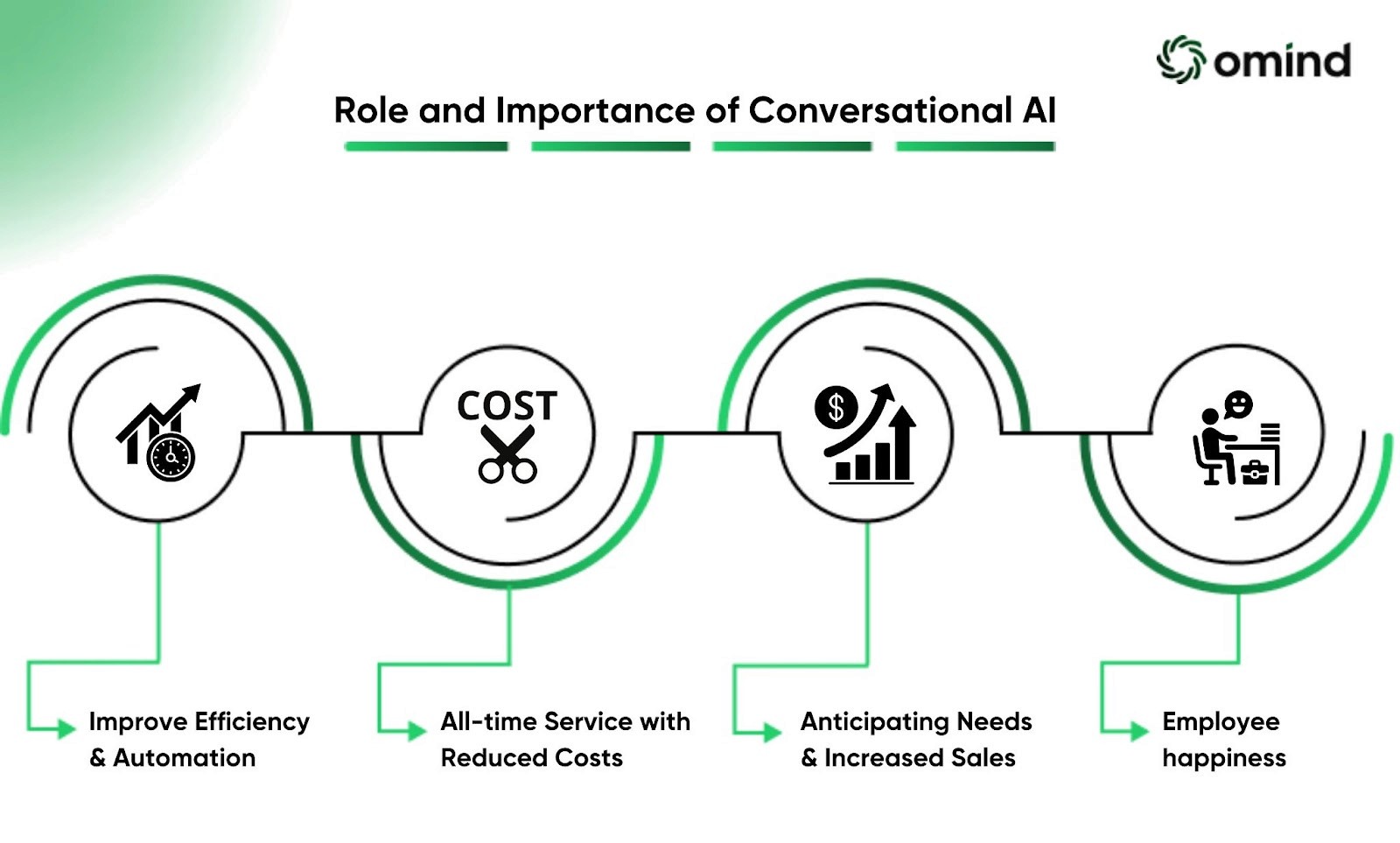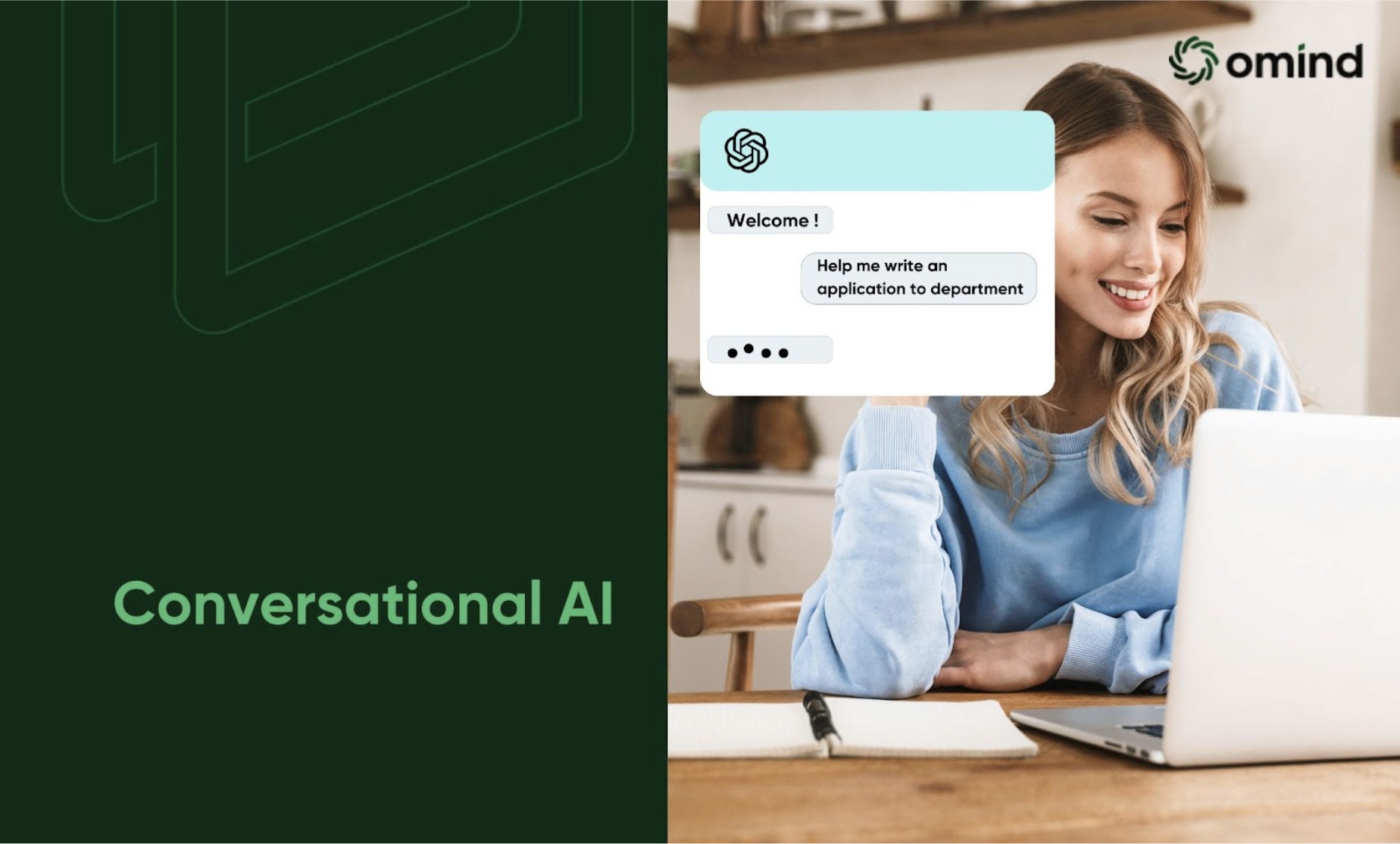The arrival of conversational AI positively influences all types of businesses, especially those dealing with customers. It can chat with clients, help employees, and do more to simplify things. Giving a unified customer experience is vital, and that dream can be achieved by implementing AI chatbots and voice assistance. Conversational AI has three main parts: artificial intelligence, machine learning, and natural language processing. They work together and understand, process, and communicate with the person dealing with them.
It automates jobs and makes things better for your employees and customers. Personalization and quick answering of customer questions are other advantages of this system. This AI often improves customer satisfaction by providing quick responses, but human intervention is still necessary for complex problems. Conversational AI examples are everywhere, from chatbots on websites to virtual helpers in mobile apps. These tools deal with many different situations, from easy questions to helping people through complicated steps. Are you looking for such a system? Read this article and learn different examples and use of conversational AI in your business.
The Role and Importance of Conversational AI in Businesses

There are many examples of conversational AI, and it is quickly changing how businesses deal with their customers and how they operate to gain a grip on the market.
Let's explore how this AI technology helps businesses:
Improve Efficiency and Automation: This technology allows companies to automate everyday duties like answering FAQs, arranging meetings, and processing simple returns. Your organization now increases efficiency and productivity and helps workers develop their skillsets and contribute more. Are you looking for an option for automation? Omind's platform can be an effective tool for achieving these goals.
All-time Service with Reduced Costs: Would you be happy if you could get service at a time convenient for you? Everybody is not free during working hours, but Conversational AI chatbots provide 24/7 availability, allowing clients to get answers and resolve problems anytime and anywhere. Whether you are using platforms like websites, mobile apps, or messaging services, all are possible now.
Anticipating Needs and Increased Sales: Machine learning assesses behaviors and changes according to the situation. AI chatbots can anticipate customer needs by analyzing past interactions and offer personalized suggestions or proactive support. A unified customer experience like this is vital for improving satisfaction and loyalty. Additionally, you can program chatbots to upsell and cross-sell relevant goods or services during conversations, possibly increasing sales.
Employee happiness: When an organization uses the latest technology, like Artificial Intelligence (AI), to do simple tasks and offers self-service assistance for employees, it improves their happiness. Now, employees mostly do only challenging work with this innovation, which can lead to increased employee morale, motivation, and a feeling of accomplishment. A more satisfied workforce offers better customer service, showcasing your uniqueness. These are some conversational AI examples of benefits a business gets that change how it deals with customers and employees. The solutions you get from vendors like Omind focus on boosting employee productivity and happiness through advanced AI technology.
Examples of Conversational AI in Action
It's not fiction or a dream now; conversational AI examples are seen in businesses across various industries. Here are some real-world examples of how conversational AI is changing interactions:
Chatbots for Every Need: Imagine a retail website where a chatbot helps you find the perfect outfit by offering styles based on your tastes and past purchases. It can also do some other jobs like resetting passwords or tracking orders.
Advanced Purposes: Chatbots are improving, handling complex questions, and providing technical support to customers. For instance, an AI chatbot in the bank could answer general questions about loan applications or direct clients to appropriate resources.
Virtual Assistants for Personalized Experiences: Do you remember Siri and Alexa? These virtual assistants can do many things in our daily lives, from offering weather updates and news headlines to setting reminders and controlling smart home devices. They all make your life simple and better.
Interactive Voice Assistants (IVAs) Support: IVAs take virtual help to the next level. They can engage in natural, two-way conversations, understand complex questions, and reply with relevant information. A travel agency using this can provide personalized vacation plans based on your interests and budget, or an IVA for a car manufacturer can provide detailed information about a particular vehicle model.
Voice-Activated Bots for Call Management: In healthcare and financial institutions, voice-activated bots can handle many incoming calls. Patients can make appointments, refill prescriptions, or get basic health information. In the financial sector, customers can check account balances, transfer funds, or troubleshoot common banking problems – all with a convenient voice interaction.
Content Generation Bots: Content creators, especially small businesses, may use conversational AI bots to optimize their processes. These bots can analyze existing content, suggest relevant keywords and topics, and create drafts or outlines. This saves time and resources while ensuring content is well-structured and engaging.
Implementing Conversational AI in Modern Businesses

You might have seen conversational AI examples before you take the next step, but having a clear implementation method, such as planning and execution, will get your business out of trouble. Here's a plan to guide you through this process:
Identifying Business Objectives:
Start with a clear vision: A vision is what you want before you start something, and the same is applicable here. Before diving in, outline your goals for using conversational AI. Will you improve customer service response times, personalize marketing messages, or automate tasks? Your overall business strategy needs to ensure the chosen conversational AI solution achieves the desired impact.
Identify target audience: Who will connect with your conversational AI? It may be your workers or customers but know them to tailor the AI's capabilities and communication style to their specific needs and preferences.
Building and Optimizing for Engagement:
Focus on user experience: The one you choose must be user-friendly and engaging. Ensure it understands natural language, provides clear and concise answers, and offers a smooth interaction flow.
Train and refine: AI is best, but training for improvement based on user interactions is essential. Analyze data to find areas for improvement, such as better handling moderately complex questions or providing more personalized recommendations.
Using Conversational AI Across Departments:
Customer Support: Chatbots can answer FAQs, troubleshoot common issues, and even escalate problems to human agents if required. The experienced hand you get from the Omind AI system integrates across various departments for maximum benefit.
Sales & Marketing: Conversational AI examples in marketing messages qualify leads and even guide customers through the sales funnel by offering product ideas and addressing purchase concerns.
Integrating Conversational AI into Business Strategies:
Develop a launch plan: Decide where you want to integrate conversational AI (website, mobile app, messaging platforms) and build a unified customer experience across all touchpoints.
Measure and adapt: Track key metrics like customer satisfaction, resolution rates, and sales conversions to assess the success of your AI solution. Modify their performance to ensure it remains consistent with your evolving business goals.
Challenges of Conversational AI and Suggestions
Successfully implementing conversational AI examples shows how they benefit your business but have specific challenges. Here's a look at some roadblocks and possible solutions:
Natural language, filled with slang, sarcasm, and cultural references, can be challenging for conversational AI, sometimes leading to misunderstandings and frustrating user experiences. These issues can be mostly controlled with ongoing training and development. Analyzing user interactions and real-world data helps natural language understand these complexities and adapt responses accordingly.
Conversational AI sometimes needs more context awareness, leading to irrelevant or unhelpful answers. Advancements in machine learning allow AI to understand the wider context of a conversation, including past interactions and user intent. This allows it to provide more relevant and personalized responses.
This technology uses data to function and improve. So, a business must ensure data safety and security to build user trust. A firm must be open about gathering and using user data. Providing users with control over their data and clear opt-in/opt-out choices to address privacy concerns and build trust. Use Omind's data privacy and offer transparent and secure AI solutions.
Not everyone is comfortable dealing with machines. Overcoming this situation is important for widespread adoption. Show the benefits of conversational AI – faster service, personalized support, and convenience. This may encourage users to adopt it, at least in the future. Offer a good user experience and slowly develop trust and comfort with conversational AI technology.
Future Outlook and Strategic Impact of Conversational AI

Digitalization is still in development, so conversational AI is, too, but the future holds great promise in this sector. Let's take a glimpse into what's on the horizon:
Conversational AI is changing and becoming even more advanced. Improvements in natural language processing (NLP) and machine learning (ML) will allow AI chatbots and virtual assistants to understand complex questions, engage in deep conversations, and adapt to individual user preferences. It spans various fields like education, finance, retail, and more and may offer more support in the future.
Businesses that see conversational AI examples and adopt them will gain a major competitive edge in personalized customer experiences, automating routine tasks, and improving operational efficiency.
You can also predict that AI chatbots will be able to understand customer sentiment, build rapport, and provide empathetic support to improve customer happiness and loyalty.
The data collected now can be used to improve product development, marketing strategies, and general customer experience. More than basic work, AI-powered virtual assistants can handle employee onboarding and schedule meetings, freeing up important employee time and resources.
Have you seen the conversational AI examples and their future predictions? If you want to improve customer engagement and gain a competitive edge, don't look for options other than Omind. Providers like Omind use cutting-edge conversational AI to build personalized customer journeys. Request a call and explore how our expertise can help take your business to the next level.
| Name | Points |
|---|---|
| Dom | 6000 |
| Melissa | 5150 |
AUTHOR
Team Omind
Empowering Businesses with Unified Customer Experience Platform, Leveraging Advanced AI and Intelligent Automation
PRODUCT
Conversational AI
Share LINK
Related Blogs



